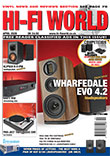Noise |
|
A signal buried in noise. WHAT IT TELLS US Noise is a measure of hiss and hum. Noise in the form of hiss is very low in modern solid-state amplifiers, well below audibility, measuring lower than -100dB. It is not a problem, except in some moving coil (MC) phono stages. Valve amplifiers also produce little hiss, but they may well suffer hum, according to the valves used and their heater supplies. Old fashioned directly heated triodes like the 211 and 300B in particular suffer hum and need special suppression measures like ‘hum bucking’ (cancelling) circuits. Modern valve preamps and power amps commonly supply d.c. to the heaters of the first stage to minimise hum. 
HOW WE MEASURE IT We measure hiss level relative to full output, using IEC A weighting. The amplifier’s input is shorted to ground with a shorting plug and the volume control adjusted until hiss is at a maximum, which is commonly at the electrical centre of the volume control track (near half volume). This shows most noise comes from the volume control, which produces thermal or Johnson noise like any resistor. When both ends are at ground potential, resistance and noise are a maximum at half volume, where a 10k input potentiometer acts as a 5k input resistor, to which noise is added from the first amplifying device. The total input noise is amplified, typically x100 (+40dB) to produce noise at the amplifier’s output. A 5k resistor alone would produce an unweighted output noise figure of -107dB. In practice output noise values, when IEC A weighted, typically range from -90dB to -110dB or so, our measurements show.
The noise floor of a Rega Elicit Line input, unweighted. The Rega has high sensitivity, explaining the high-ish noise figure of -84dB (volume at max., input shorted). Weighting is used to avoid the noise figure being dominated by small amounts of hum. Where hum is significant, in valve amplifiers for example, we measure the rms output voltage (unweighted) and use 1mV as a ‘rule of thumb’ upper limit, from our experience designing and using World Audio Design valve amplifiers. Loudspeaker sensitivity comes into this of course; 1mV will be more audible through a sensitive floor stander than an insensitive bookshelf type.
The noise floor of an Icon Audio MB150 valve power amplifier (set to High sensitivity), unweighted. Hiss is very low, and hum (the peaks at left) dominates.
Phono stage noise is dominated by the input stage, including any resistor used to define the 47k input resistance of an MM stage. In most circuits this is shunted by the d.c, resistance of the cartridge coils, around 1500 Ohms, to produce a total input noise current. We measure phono stage noise using a short circuited input and divide output noise by gain at 1kHz to derive an equivalent input noise figure. IEC A weighting is used. Noise values obtained by this method are typically around 0.6uV. The same measurement technique is used with moving coil input stages. Noise values are typically around 0.1uV, varying widely according to circuit topology, which for MCs tends to vary more widely than it does for MMs. A low input impedance step-up transformer will produce around 0.03uV of input noise for example, a higher input impedance type 0.08uV and solid-state inputs from 0.06uV up to 2uV. A moving coil cartridge presents a load of a few ohms to an input, so it is quiet in itself and the lower impedances within the input circuits of an MC preamp generate less noise. However, balancing this is very low output, down to 0.2mV from some moving coil cartridges, and with such a weak signal, input noise will be audible from almost all phono stages. |








